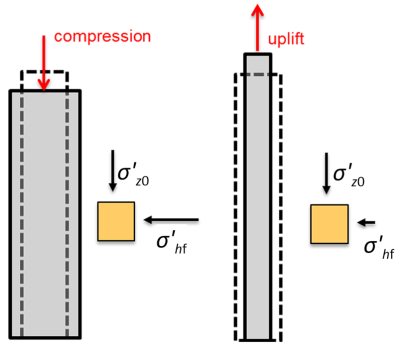6.15 Ultimate geotechnical strength of piles subjected to axial tensile loads
In the simplest yet most common case of a pile without an enlarged base, its resistance to uplift axial loads is directly estimated as the sum of the skin friction resistance and the dead weight of the pile:
(6.74) ![]()
If the α-method or the ICP method is used to determine the pile’s tensile collapse load Qf,t, the skin friction resistance developing during uplift of piles installed in soft fine-grained soils is assumed to be equal to the friction resistance in compression, and is estimated with the formulas presented in Chapter 6.9 (α-method) and Section 6.12.7 (ICP method for piles in fine-grained soils).

Under drained conditions, the skin friction resistance to pile uplift fsf,t is reduced due to the Poisson effect (Figure 6.43), which results in lower confining stress at the side of the shaft and thus reduced friction compared to fsf (Reese et al., 2006, AS 2159). In that case, the skin friction stress developing at the interface to resist tensile an axial load may be computed as:
(6.75) ![]()
where the reduction factor ψt is given by the formula (Reese et al., 2006):
(6.76a) ![]()
(6.76b) ![]()
where φi is the interface friction angle; Es,aver is the average Young modulus of the soil along the pile; Ep is the Young modulus of the pile’s material; vp is the Poisson ratio of the pile’s material; L is the pile’s length; D is the pile’s diameter.
Τhe reduction factor ψt estimated from Eq. 6.76 ranges from 0.75 to 0.85 for typical piles, and can be conservatively taken equal to 0.75. The above formulas were originally proposed for coarse-grained soils, but can be used conservatively for fine-grained soils under long-term uplift loading.
The ICP-05 method for piles in coarse-grained soils, presented in Section 6.12.5 can also be used to estimate the skin friction resistance fsf,t developing in piles subjected to axial tensile loads. For closed-end cylindrical piles Eq. 6.35 that provides the skin friction stress becomes:
(6.77) ![]()
i.e., the normal stress acting at the soil-pile interface after equilibration is reduced by 20%, which is comparable with Eq. 6.76 and the recommended ψt values.
For open-ended pipe piles Jardine et al. (2005) recommend further reducing fsf,t by another 10%, as:
(6.78) ![]()

